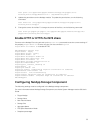
After you modify the dhcpd.conf file based on your environment, you need to start or restart your
DHCPD service. For more information, see http://ipxe.org/howto/dhcpd
Sample DHCP Configuration
# dhcpd.conf
#
# Sample configuration file for ISC dhcpd
#
#option definitions common to all supported networks...
#option domain-name "example.org";
#option domain-name-servers 192.168.203.46;
#filename "pxelinux.0";
next-server 192.168.123.21;# IP address of ASM Server
default-lease-time 6000;
max-lease-time 7200;
# Use this to enble / disable dynamic dns updates globally.
#ddns-update-style none;
# If this DHCP server is the official DHCP server for the local
# network, the authoritative directive should be uncommented.
authoritative;
# Use this to send dhcp log messages to a different log file (you also
have to hack syslog.conf to complete the redirection.
log-facility local7;
# No service will be given on this subnet, but declaring it helps the
# DHCP server to understand the network topology.
#subnet 192.168.123.0 netmask 255.255.255.0 {
#}
# This is a very basic subnet declaration.
subnet 192.168.123.0 netmask 255.255.255.0 {
range 192.168.123.24 192.168.123.29;
option subnet-mask 255.255.255.0;
option routers 192.168.123.1;
if exists user-class and option user-class = "iPXE" {
filename "bootstrap.ipxe";
} else {
filename "undionly.kpxe";
}
}
# This declaration allows BOOTP clients to get dynamic addresses,
# which we don't really recommend.
47


















